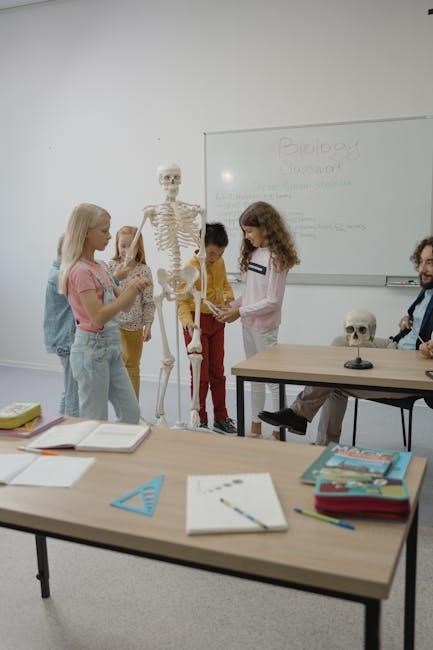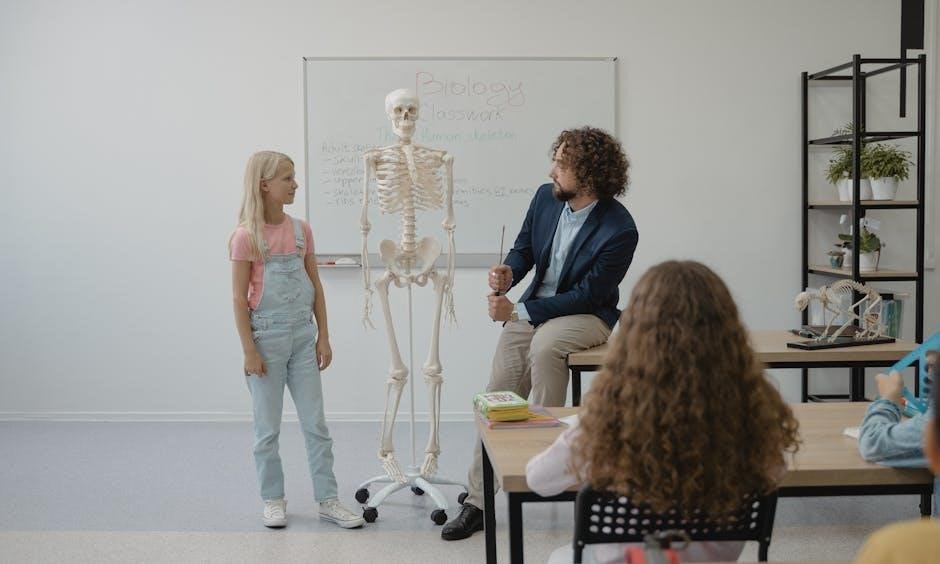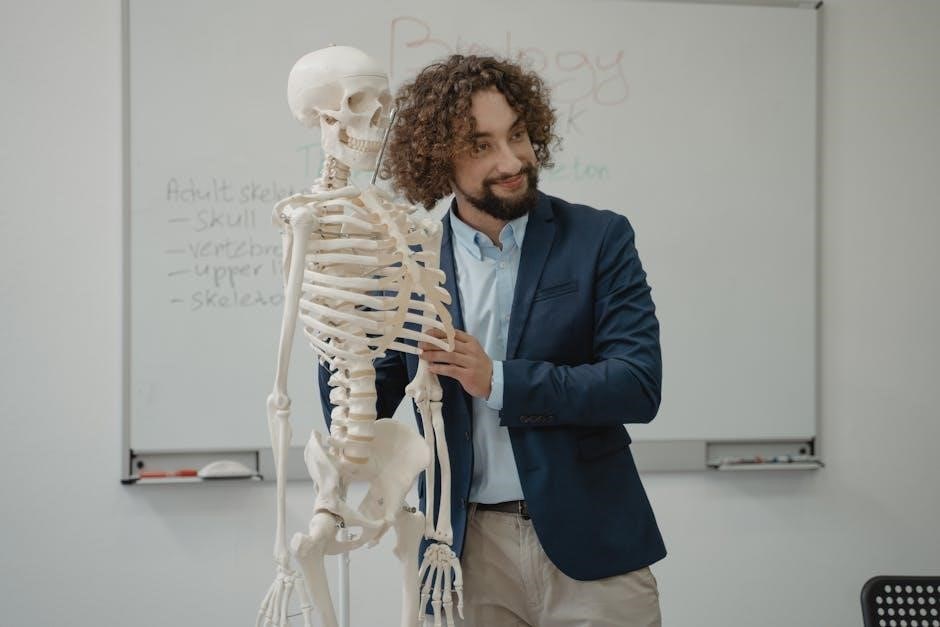Co-teaching models are collaborative instructional strategies where two teachers work together to deliver content, enhancing teaching effectiveness and student outcomes in inclusive classrooms.
Definition and Overview
Co-teaching models are instructional delivery methods where two teachers collaborate to plan, organize, and deliver lessons to a shared group of students. This approach emphasizes teamwork, with both educators contributing their expertise to create a supportive and inclusive learning environment. Co-teaching is widely used in inclusive classrooms to meet diverse student needs, ensuring that all learners receive targeted instruction. The models are designed to promote active engagement, differentiated instruction, and effective classroom management. By sharing responsibilities, teachers can address various learning styles and abilities, fostering academic success and social growth. Co-teaching is a flexible and adaptable strategy that enhances teaching effectiveness and student outcomes, making it a valuable tool in modern education.
Importance of Co-Teaching in Education
Co-teaching holds significant importance in education as it fosters a collaborative learning environment, benefiting both students and teachers. By pooling their expertise, educators can address diverse student needs more effectively, ensuring personalized instruction and support. This approach enhances academic outcomes, particularly for students with special needs, by providing differentiated instruction. Additionally, co-teaching promotes professional development among teachers, encouraging shared knowledge and innovative strategies. It also strengthens classroom management and reduces teacher workload, allowing for more efficient lesson delivery. Ultimately, co-teaching models contribute to a more inclusive and equitable education system, preparing students for future success while empowering educators through teamwork and shared responsibility.
Benefits for Students and Teachers
Co-teaching offers numerous benefits for both students and educators. Students receive personalized attention and tailored instruction, addressing their diverse learning needs effectively. This collaborative approach enhances academic engagement and understanding, particularly for students with special needs. Teachers benefit from shared responsibilities, reducing workload and fostering professional growth through teamwork. Co-teaching also promotes innovative teaching strategies and mutual support, leading to improved classroom management and student outcomes. Additionally, it encourages ongoing professional development, as educators learn from each other’s strengths and expertise. Overall, co-teaching creates a more inclusive and dynamic learning environment, benefiting all stakeholders involved in the educational process.

The Six Co-Teaching Models
The six co-teaching models include One Teach, One Observe; One Teach, One Assist; Station Teaching; Alternative Teaching; Parallel Teaching; and Team Teaching, each offering unique instructional strategies to enhance learning experiences.
One Teach, One Observe
In the One Teach, One Observe model, one teacher delivers the lesson while the other observes students or the teaching process. The observing teacher focuses on specific behaviors, such as student engagement or instructional strategies. This model allows for detailed feedback and reflection, enhancing teaching practices. Observations are preplanned, ensuring focused data collection. After the lesson, both teachers analyze the findings to refine instruction. This approach supports professional development and improves student outcomes by identifying areas for growth. It is particularly effective for assessing classroom dynamics and teacher effectiveness, fostering a collaborative environment for continuous improvement.
One Teach, One Assist
In the One Teach, One Assist model, one teacher leads the lesson while the other provides support to students. The assisting teacher helps individuals or small groups, reinforcing concepts and addressing questions. This model is ideal for activities like drill and practice, reteaching, or review, as it allows for targeted assistance. The primary teacher maintains instructional control, while the co-teacher ensures all students stay engaged. This approach promotes active participation and reduces barriers to learning. It is particularly effective in inclusive classrooms, enabling differentiated support and fostering a collaborative learning environment. The assisting teacher’s role is flexible, adapting to student needs and enhancing overall lesson effectiveness.
Station Teaching
Station Teaching organizes the classroom into small groups, each rotating through learning stations. Teachers divide content or students, with each leading a station. This model allows for personalized instruction, as teachers can tailor their approach to the needs of each group. It is particularly effective for hands-on activities, differentiated instruction, and collaborative learning. The structured rotation ensures all students engage with the material, while teachers can provide targeted support. This method promotes active participation and caters to diverse learning styles; By dividing responsibilities, teachers can maximize instructional efficiency and student outcomes, making it a versatile and engaging co-teaching strategy.
Alternative Teaching
Alternative Teaching involves one teacher instructing a large group while the other works with a smaller group, allowing for differentiated instruction. This model is ideal for modifying lessons to meet diverse student needs, such as providing additional support or challenging advanced learners. Teachers can pull a small group for targeted instruction while the other teacher engages the majority of the class. This approach promotes personalized learning and flexibility, enabling teachers to cater to varying learning styles and pacing. By dividing responsibilities, educators can ensure all students receive tailored attention, enhancing engagement and understanding. This method is particularly effective for addressing specific skill gaps or enriching content for different learners.
Parallel Teaching
Parallel Teaching is a co-teaching model where both teachers simultaneously instruct the same content to different groups of students within the same classroom; This approach ensures that all learners receive consistent instruction while allowing teachers to tailor their delivery to the specific needs of their group. The classroom is often divided into two sections, with each teacher leading a group. This method promotes active engagement and reduces the student-to-teacher ratio, enabling more individualized attention. Teachers can use similar strategies or adapt their methods based on student responses, fostering a collaborative and dynamic learning environment. Parallel Teaching is particularly effective for reinforcing concepts and ensuring equity in instruction for all students.
Team Teaching
Team Teaching involves both co-teachers actively instructing the entire class simultaneously, sharing leadership and responsibility for delivering the lesson. This model emphasizes collaboration, with both teachers contributing their expertise to create a unified instructional approach. There is no designated leader; instead, teachers seamlessly interchange roles, providing students with diverse teaching styles and perspectives. This method fosters a dynamic learning environment, allowing teachers to complement each other’s strengths and engage students through varied instructional strategies. Team Teaching promotes active participation from all learners and encourages peer-to-peer learning. By working together, teachers can address a broader range of student needs, making this model particularly effective for inclusive classrooms.

Characteristics of Each Co-Teaching Model
Each model has unique characteristics, such as classroom setup, teacher roles, and instructional strategies, tailored to meet diverse student needs and enhance collaborative teaching practices effectively.
One Teach, One Observe: Classroom Setup and Advantages
In the One Teach, One Observe model, one teacher delivers instruction while the other focuses on observing students or teaching methods. The lead teacher is typically at the front, ensuring all students can see and engage, while the observer may be stationed unobtrusively or move around the room. This setup allows for detailed observation of student behaviors, academic engagement, or social interactions. The observing teacher gathers specific, pre-determined data, which is later analyzed collaboratively. This model is ideal for assessing student needs, monitoring progress, and refining instructional strategies. It also provides opportunities for teachers to reflect on their practices and improve collectively, ultimately enhancing the learning experience for all students.
One Teach, One Assist: Roles and Responsibilities
In the One Teach, One Assist model, one teacher takes the primary instructional responsibility, delivering the lesson to the entire class. The second teacher acts as a support, assisting students who may need additional help, clarifying concepts, or providing scaffolding. This model is particularly effective for differentiated instruction, as the assisting teacher can work with smaller groups or individual students. Roles are clearly defined, with the lead teacher focusing on content delivery and the assistant ensuring student understanding. This setup promotes active engagement and reduces the teacher-student ratio, allowing for more personalized attention. It also fosters collaboration between teachers, enhancing instructional effectiveness and student outcomes.
Station Teaching: Organizing the Classroom
Station Teaching involves organizing the classroom into multiple learning stations, each with a specific activity or instructional focus. Teachers divide students into small groups, rotating them through stations to engage with different tasks. Both co-teachers are actively involved, each managing a station to provide targeted instruction. This model promotes active learning, as students interact with varied content and instructional strategies. The classroom setup requires careful planning to ensure smooth transitions and equitable distribution of resources. Station Teaching fosters collaboration, allowing teachers to cater to diverse learning needs while maintaining a structured and engaging learning environment. It is particularly effective for hands-on activities and differentiated instruction.

Alternative Teaching: Strategies for Differentiated Instruction
Alternative Teaching is a co-teaching model where one teacher instructs the majority of the class while the other works with a smaller group, providing tailored instruction. This setup allows for differentiated instruction, as teachers can modify content, pace, or strategies to meet specific student needs. The lead teacher delivers core concepts to the larger group, while the co-teacher offers enriched or remedial instruction to the smaller group. This model is ideal for addressing diverse learning levels and styles, ensuring all students receive targeted support. Effective planning and communication are essential to align lesson goals and assessments, making it a powerful strategy for inclusive classrooms.
Parallel Teaching: Promoting Active Engagement
Parallel Teaching involves both teachers delivering the same instruction simultaneously to different groups of students. This model promotes active engagement as each teacher can address a smaller group, fostering a more interactive learning environment. Students benefit from focused attention and opportunities to participate, while teachers can tailor their delivery to meet the needs of their group. This approach enhances collaboration and ensures that all students are actively involved in the learning process, making it an effective strategy for promoting student engagement and understanding. By dividing the class, teachers can create a more dynamic and inclusive classroom setting.
Team Teaching: Collaborative Lesson Delivery
Team Teaching is a co-teaching model where both teachers share instruction delivery, often interchangeably, creating a collaborative learning environment. This approach allows for real-time teacher interaction and flexibility, as both educators contribute equally to lesson delivery. Students benefit from diverse teaching styles and perspectives, enhancing engagement and understanding. Team Teaching fosters a dynamic classroom atmosphere where both teachers are actively involved, often without a clear distinction of roles. This model requires strong communication and planning between co-teachers to ensure seamless delivery. By sharing instructional responsibilities, teachers can cater to different learning styles and needs, making it an effective strategy for inclusive education. This collaborative approach promotes a cohesive and supportive learning experience for all students.

Implementing Co-Teaching Models Effectively
Co-teaching success relies on careful planning, clear communication, and defined roles to ensure alignment with lesson goals and student needs for optimal instructional delivery.
Matching Models to Lesson Elements
Matching co-teaching models to specific lesson elements ensures effective instruction. For instance, One Teach, One Observe is ideal for assessing student behaviors or teacher strategies during delivery. Station Teaching works well for differentiated instruction, allowing teachers to cater to varied learning needs by dividing students into smaller groups. Parallel Teaching is beneficial for reinforcing concepts, as both teachers deliver the same content to different groups, promoting consistency and understanding. Alternative Teaching is best suited for providing targeted interventions or extensions, while Team Teaching fosters a collaborative environment where both teachers actively engage with all students. By aligning models with lesson goals, educators can maximize instructional impact and support diverse student needs effectively.

Preparing for Co-Teaching: Planning and Organization
Effective co-teaching begins with thorough planning and organization. Teachers must collaborate to align instructional goals, define roles, and structure lessons. Co-planning meetings are essential to ensure both teachers are on the same page, discussing lesson objectives, materials, and student needs. Creating detailed lesson plans helps outline responsibilities and timelines, preventing confusion. Assessing student data beforehand allows teachers to identify areas where co-teaching can most benefit learners. Organizing classroom space and resources in advance also supports smooth implementation. By establishing clear communication channels and shared expectations, co-teachers can deliver cohesive instruction, fostering a productive learning environment tailored to student needs.
Assessing Readiness for Co-Teaching
Assessing readiness for co-teaching involves evaluating teachers’ willingness and ability to collaborate effectively. Teachers should self-reflect on their teaching styles, communication skills, and openness to shared responsibility. Schools can use surveys or checklists to gauge readiness, focusing on factors like trust, respect, and shared goals. Professional development opportunities can address gaps in collaboration skills or co-teaching knowledge. Both teachers and administrators must commit to fostering a supportive environment. By ensuring teachers are prepared and willing to co-teach, schools can set the foundation for successful implementation and improved student outcomes.

Collaborative Aspects of Co-Teaching
Collaborative aspects of co-teaching emphasize teamwork, shared responsibilities, and open communication between educators to create a unified learning environment for students.
Communication Strategies for Co-Teachers
Effective communication is the cornerstone of successful co-teaching. Co-teachers must establish clear channels for sharing ideas, planning lessons, and providing feedback. Scheduled meetings and open dialogue ensure alignment in instructional goals and strategies. Verbal and non-verbal cues during lessons help maintain consistency and address student needs promptly. Active listening and mutual respect foster a collaborative environment, while agreed-upon communication protocols prevent misunderstandings. Digital tools, such as shared documents or messaging apps, can enhance coordination and organization. Regular reflection on communication practices allows co-teachers to refine their approach, ensuring seamless teamwork and improved student outcomes. Strong communication fosters trust, professionalism, and a cohesive learning experience for all students.
Building Trust and Professional Relationships
Trust and professional relationships are essential for effective co-teaching partnerships. Co-teachers must foster mutual respect, transparency, and open dialogue to create a supportive environment. Sharing responsibilities and decision-making processes promotes equality and collaboration. Regular feedback sessions ensure both teachers feel valued and heard, strengthening their partnership. Celebrating successes and addressing challenges collectively builds resilience and trust. Professional development opportunities can further enhance these relationships by providing co-teachers with shared goals and strategies. A strong foundation of trust ensures that co-teachers work seamlessly together, ultimately benefiting student learning and classroom dynamics. By prioritizing relationship-building, co-teachers can create a positive and productive collaborative experience.
Shared Responsibilities and Decision-Making
Shared responsibilities and collaborative decision-making are cornerstone principles of co-teaching. Both teachers equally contribute to lesson planning, delivery, and assessment, ensuring a balanced approach to instruction. This shared ownership fosters accountability and enhances teaching effectiveness. Decision-making is a joint process, with both educators providing input on instructional strategies, student support, and classroom management. This collaborative approach ensures that diverse perspectives are considered, leading to more comprehensive and inclusive teaching practices. By sharing responsibilities, co-teachers can address various student needs while maintaining a cohesive learning environment. This partnership not only strengthens instructional delivery but also promotes a culture of mutual respect and professionalism.

School and District Factors Influencing Co-Teaching
School and district factors, such as administrative support, resource availability, professional development opportunities, and classroom environment, significantly influence the effectiveness and sustainability of co-teaching models.
Administrative Support and Resources
Administrative support and resources play a crucial role in the success of co-teaching models. Schools and districts must provide teachers with professional development opportunities to understand and implement co-teaching strategies effectively. Access to resources such as co-teaching guides, training materials, and technology can enhance collaboration and lesson planning. Additionally, administrative backing ensures that co-teaching initiatives are prioritized and sustained over time. Without adequate support, co-teaching programs may struggle to meet their full potential, emphasizing the need for district-level commitment to fostering collaborative teaching environments. Effective allocation of resources and administrative encouragement are essential for creating a sustainable and impactful co-teaching framework.
Professional Development Opportunities
Professional development opportunities are essential for educators to master co-teaching models. Workshops, training sessions, and collaborative planning initiatives help teachers build the necessary skills and confidence to implement these models effectively. Schools and districts should provide ongoing support, including hands-on training and feedback sessions, to ensure teachers are well-prepared. Opportunities for reflection and peer discussion further enhance professional growth. By investing in teacher development, educational institutions can foster a culture of collaboration and innovation, ultimately benefiting both educators and students. Continuous learning ensures co-teaching strategies remain dynamic and aligned with evolving educational needs.
Classroom Environment and Student Needs
The classroom environment plays a pivotal role in the success of co-teaching models, as it must accommodate diverse student needs and instructional strategies. A well-organized space with flexible seating arrangements can facilitate small-group work, stations, or parallel teaching. Visibility and accessibility are crucial, ensuring all students can engage with both teachers. Assistive technologies and resources should be integrated to support students with special needs. Co-teachers must also consider the emotional and social dynamics of the classroom, fostering an inclusive atmosphere that encourages participation and collaboration. By aligning the classroom setup with student needs, co-teachers can create a learning environment that maximizes engagement and accommodates diverse learning styles, ensuring all students benefit from the instructional approach.

Evaluating the Effectiveness of Co-Teaching
Evaluating co-teaching involves assessing student outcomes, monitoring teacher collaboration, and using data-driven strategies to refine instructional practices and ensure continuous improvement in teaching and learning environments.

Assessing Student Outcomes
Assessing student outcomes in co-teaching involves evaluating academic performance, social skills, and behavioral growth. Teachers use formal and informal assessments to measure progress toward learning goals.
Data from observations, quizzes, and projects helps identify strengths and areas needing improvement. This information is used to refine instruction and ensure differentiated support for all learners.
Co-teachers collaborate to analyze student data, ensuring assessments align with lesson objectives. By monitoring outcomes, educators can adapt strategies to meet diverse student needs effectively.
Regular assessment ensures co-teaching models remain impactful, fostering student success and continuous improvement in instructional practices.
Monitoring Teacher Collaboration
Monitoring teacher collaboration ensures effective teamwork and alignment in co-teaching. Regular communication and structured meetings help maintain clear roles and responsibilities.
Co-teachers engage in reflective practices, discussing challenges and successes to refine their strategies. This ongoing dialogue fosters trust and strengthens professional relationships.
Administrators and support staff play a role in observing co-teaching dynamics, providing feedback to enhance collaborative efforts. Professional development opportunities further support teachers in improving their teamwork.
By consistently monitoring collaboration, educators can address issues promptly, ensuring a cohesive and productive teaching environment that benefits both teachers and students.
Continuous Improvement Strategies
Continuous improvement in co-teaching involves ongoing evaluation and adaptation of teaching methods. Teachers reflect on lesson effectiveness and student feedback to identify areas for growth.
Professional development opportunities, such as workshops and peer observations, provide teachers with new strategies to enhance their co-teaching practices.
Regular collaboration and open communication between co-teachers ensure alignment and refinement of instructional approaches, fostering a culture of shared responsibility and innovation.
By implementing these strategies, educators can continuously refine their co-teaching methods, leading to improved student outcomes and a more effective learning environment.
Co-teaching models enhance instructional delivery through collaboration, benefiting both teachers and students by promoting active engagement, personalized learning, and inclusive education.
The six co-teaching models—One Teach, One Observe; One Teach, One Assist; Station Teaching; Alternative Teaching; Parallel Teaching; and Team Teaching—offer flexible strategies for educators to collaborate effectively. These models support differentiated instruction, allowing teachers to cater to diverse learning needs while fostering active student engagement. By sharing responsibilities, teachers can enhance lesson delivery, provide targeted support, and assess student progress more effectively. The impact of co-teaching extends beyond academics, promoting inclusivity, teamwork, and professional growth for educators. When implemented thoughtfully, these models create a dynamic and supportive learning environment, ultimately benefiting both students and teachers alike.
Future Trends in Co-Teaching Practices
Future trends in co-teaching emphasize technology integration, personalized learning, and professional development. Digital tools will enhance collaboration, enabling teachers to co-plan and deliver lessons remotely. Personalized learning plans will become more prevalent, tailoring instruction to individual student needs. Professional development will focus on refining co-teaching strategies and fostering cultural responsiveness; There will also be a greater emphasis on data-driven practices to assess co-teaching effectiveness. These trends aim to create more inclusive, flexible, and impactful learning environments, ensuring that co-teaching continues to evolve as a powerful instructional approach in modern education.